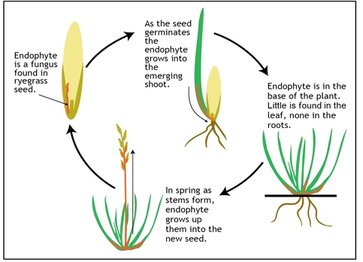Ryegrass endophyte
What is endophyte?

Endophyte is a fungus (called Neotyphodium lolii) that greatly affects animal health and performance. It is found only in perennial, long rotation and some hybrid ryegrasses. It lives completely within the plant and is only visible under a microscope. Endophyte occurs naturally, and found in many old pastures.
Why have endophyte?
Endophyte protects plants from a range of insects. In summer dry situations ryegrass containing endophyte consistently out-yields and persists better than ryegrass without endophyte.
Why do you need to know about endophyte?
- The traditional standard endophyte reduces animal production and can cause ryegrass staggers
- New endophytes stop staggers and improve animal performance
- If seed without endophyte is sown, the resultant plants will never have endophyte. It does not transfer from plant to plant, or from the soil
Why do you need to know about endophyte?
- The traditional standard endophyte reduces animal production and can cause ryegrass staggers
- New endophyte Plus AR1, Plus NEA2 and AR6 stop staggers and improve animal performance
- Where ryegrass with Plus AR1 or Plus NEA2 advanced endophyte is sown, the resultant plants will always have Plus AR1 or Plus NEA2 endophyte
- If seed without endophyte is sown, the resultant plants will never have endophyte. It does not transfer from plant to plant, or from the soil
Low Endophyte (LE)
Low Endophyte grasses provides better animal performance than High Endophyte ones but the downside of this is that it won’t persist as well.
High / Standard Endophyte (HE/SE)
High/ Standard Endophyte is still available in some older varieties. It is not recommended because it causes ryegrass staggers, depresses liveweight gains in lambs and reduces milk production in dairy cows. This type of endophyte persists extremely well in tough conditions.
AR1 Endophyte
Ryegrass with AR1 endophyte is a non-staggering endophyte that has excellent animal performance. However, the Peramine does not give good resistance against Black Beetle, and care is needed in areas with high Black Beetle numbers.
AR1 endophyte in ryegrass offers the following benefits:
- Better liveweight gains and milk production than wild-type endophyte ryegrass
- No ryegrass staggers
- No heat stress
- Less dags and flystrike
- No prolactin depression
- Excellent control of Argentine stem weevil
- Pasture productivity similar to that of wild-type endophyte ryegrass
- Better pasture persistence than endophyte-free ryegrass
AR37 Endophyte
Ryegrass with AR37 gives simple, economical insect control and around the clock protection from most pasture pests. AR37’s continual and superior insect protection ensures maximum pasture production and better pasture persistence allowing higher animal productivity. AR37 endophyte in ryegrass offers the following benefits:
- Greater insect protection
- Continual protection against Argentine Stem Weevil, Adult Black Beetle, Pasture Mealy Bug, Root Aphid and Porina
- Improves tiller density and persistence of perennial ryegrass
- Maximises animal performance
- Higher pasture productivity allowing higher animal productivity and more profit
NEA2 Endophyte
NEA2 endophyte is ideally suited to intensive farming systems, providing persistent, staggers free pasture with excellent animal performance. Ryegrass with NEA2 gives good control of black beetle, to the same level as AR37. It also provides a level of control of Argentine stem weevil (ASW), pasture mealy bug (provisional rating) and root aphid, higher in the diploid cultivar Trojan than in Bealey.
NEA4 Endophyte
NEA4 is similar to NEA2 in terms of alkaloid expression, producing peramine, low-med levels of ergovaline and low levels of lolitrem B.
This provides:
- strong insect protection against African black-beetle adults, Argentine stem weevil (larvae and adults), and moderate/strong protection against root aphid.
- good protection against some Australian pasture pests including Russian wheat aphid, bird cherry aphid, and rose grain aphid. This insect protection, conveyed through these alkaloids aids plant persistence and performance.
- ryegrass stagger and heat stress free pastures for cattle and very low risk of stagger issues with sheep. It is not recommended for horses due to low levels of ergovaline, that help improve persistence but can cause some health issues with foetal development. Animal safety testing with sheep, prior to release demonstrated similar animal performance to AR1, with no incidence of ryegrass staggers across 10 replicated trials from 2012-2019.
- a good balance of persistence and animal performance.
- NEA4 is available in our new mid-late heading diploid perennial Maxsyn
NEA12 Endopyte
NEA12 is a janthitrem producing endophyte.
It provides:
- Good broad insect protection against African black-beetle adults, Argentine stem weevil (larvae only), and root aphid.
- protection against Australian pasture pests including moderate protection against Russian wheat aphid, and rose grain aphid, and strong protection against bird cherry aphid. This insect protection, conveyed through these alkaloids aids plant persistence and performance.
- strong autumn recovery when compared with different endophytes in the same genetic background.
- reduced ryegrass staggers when compared with standard endophyte, however, can cause ryegrass staggers and is not as safe as other endophyte options such as NEA2, NEA4, AR1 etc. It is recommended when grazing NEA12 that animals (especially sheep) are monitored, and management strategies implemented at key times. It is NOT recommended for horses. NEA12 does not cause heat stress.
- NEA12 often provides the best option for persistence, with some compromise for animal safety.

